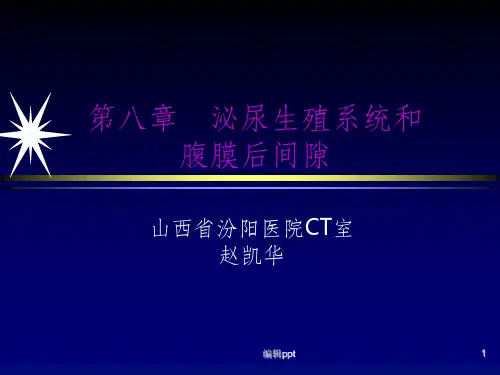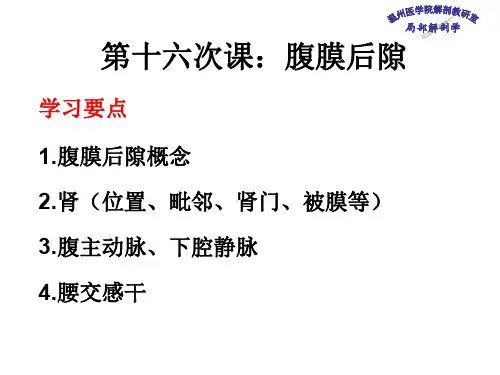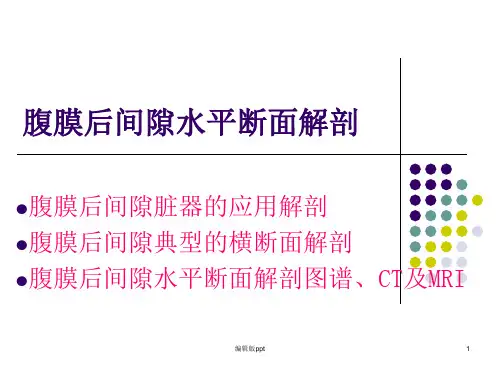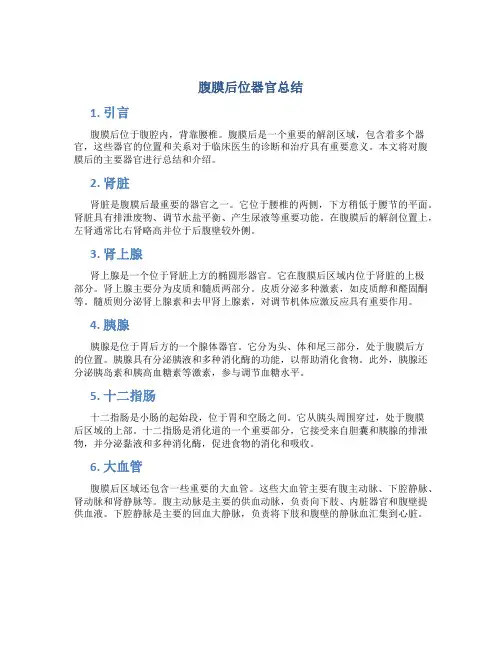腹膜后j解剖
- 格式:ppt
- 大小:9.14 MB
- 文档页数:4








腹膜后解剖结构及器官*导读:腹膜后腔是指腹后壁腹膜与腹后壁的腹内筋膜之间的间隙,上达膈肌,下抵骶胛,两侧向外接连腹膜外脂肪。
……腹膜后腔是指腹后壁腹膜与腹后壁的腹内筋膜之间的间隙,上达膈肌,下抵骶胛,两侧向外接连腹膜外脂肪。
间隙内充以疏松结缔组织,主要结构有位于脊柱前方的腹主动脉及其分支;下腔静脉及其属支;脊柱两侧的腰交感干,以及围绕腹腔干和肠系膜上动脉周围的腹腔神经丛,还有腹主动脉神经丛、肠系膜下丛和上腹下丛等植物神经丛;再向两侧为左、右肾和肾上腺以及输尿管。
胰和12指肠虽也位于此间隙内,但已述于前。
此外还有位于腰大肌深面的腰丛及其分支。
一、肾脏1. 肾的形态、位置和毗邻肾kidney是泌尿系统的主要器官,呈红褐色,可分为上、下两端,内、外两缘和前、后两面。
前面略凸隆,后面平坦;外侧缘呈弓形,凸弯向外侧,内侧缘中部凹陷,有肾动、静脉,淋巴管和输尿管出入,叫做肾门。
进出肾门的诸结构为结缔组织所包绕,叫做肾蒂。
右侧肾蒂较短。
肾蒂内结构排列的顺序是:从前向后依次是肾静脉、肾动脉、输尿管;从上向下为肾动脉、肾静脉、输尿管。
从肾门进入为一扩大的腔隙,叫做肾窦,为肾血管的分支、肾盂和肾大盏、肾小盏所占据,中间充填以脂肪组织。
肾位于脊柱两侧,两肾上端较为靠近,而下端则相距略远,即肾的长轴由风上斜向外下。
左肾上端平第11肋下缘,下端约平第二腰椎下缘。
右肾上、下端均较左肾低约半个椎骨。
第12肋斜越左肾后面中部、右肾后面上部。
肾门约平第一腰椎高度,幽门平面通过右肾门上部和左肾门下部。
两肾上端有肾上腺复盖,左肾前面从上向下分别与胃、胰尾、空肠相邻,外侧缘上部接脾,下部邻结肠左曲。
右肾前面上2/3部邻肝,下1/3部接结肠右曲,内侧缘与12指肠降部相贴。
两肾后面第12肋以上部分,隔膈肌对向肋膈隐窝(窦),故肾手术经后入路时,应予注意勿损伤肋膈隐窝,以免造成气胸。
第12肋以下部分,肾后面从内侧向外侧依次与腰大肌、腰方肌和腹横肌相邻接。


腹膜后位器官总结1. 引言腹膜后位于腹腔内,背靠腰椎。
腹膜后是一个重要的解剖区域,包含着多个器官,这些器官的位置和关系对于临床医生的诊断和治疗具有重要意义。
本文将对腹膜后的主要器官进行总结和介绍。
2. 肾脏肾脏是腹膜后最重要的器官之一。
它位于腰椎的两侧,下方稍低于腰节的平面。
肾脏具有排泄废物、调节水盐平衡、产生尿液等重要功能。
在腹膜后的解剖位置上,左肾通常比右肾略高并位于后腹壁较外侧。
3. 肾上腺肾上腺是一个位于肾脏上方的椭圆形器官。
它在腹膜后区域内位于肾脏的上极部分。
肾上腺主要分为皮质和髓质两部分。
皮质分泌多种激素,如皮质醇和醛固酮等。
髓质则分泌肾上腺素和去甲肾上腺素,对调节机体应激反应具有重要作用。
4. 胰腺胰腺是位于胃后方的一个腺体器官。
它分为头、体和尾三部分,处于腹膜后方的位置。
胰腺具有分泌胰液和多种消化酶的功能,以帮助消化食物。
此外,胰腺还分泌胰岛素和胰高血糖素等激素,参与调节血糖水平。
5. 十二指肠十二指肠是小肠的起始段,位于胃和空肠之间。
它从胰头周围穿过,处于腹膜后区域的上部。
十二指肠是消化道的一个重要部分,它接受来自胆囊和胰腺的排泄物,并分泌黏液和多种消化酶,促进食物的消化和吸收。
6. 大血管腹膜后区域还包含一些重要的大血管。
这些大血管主要有腹主动脉、下腔静脉、肾动脉和肾静脉等。
腹主动脉是主要的供血动脉,负责向下肢、内脏器官和腹壁提供血液。
下腔静脉是主要的回血大静脉,负责将下肢和腹壁的静脉血汇集到心脏。
7. 直肠和结肠腹膜后还包括直肠和结肠的部分。
直肠是位于盆腔的最末端的结肠段,负责储存和排泄粪便。
结肠是位于直肠上方的结肠管,并分为升结肠、横结肠、降结肠和乙状结肠等。
结肠的主要功能是吸收水分和电解质。
8. 总结腹膜后是一个重要的解剖区域,包含着多个重要的器官和血管。
肾脏、肾上腺和胰腺是其中最重要的器官。
了解腹膜后的器官及其位置与关系,有助于临床医生更好地进行诊断和治疗。
此外,腹膜后的大血管和消化道也具有重要的生理功能,对人体健康至关重要。

Diagnostic and Interventional Imaging(2015)96,171—186PICTORIAL REVIEW/GastrointestinalimagingRadioanatomy of the retroperitoneal spaceA.Coffin∗,I.Boulay-Coletta,D.Sebbag-Sfez,M.ZinsRadiology department,Paris Saint-Joseph Hospitals,185,rue Raymond-Losserand,75014Paris,FranceKEYWORDSRetroperitonealspace;Kidneys;Cross-sectionalanatomyAbstract The retroperitoneum is a space situated behind the parietal peritoneum and in frontof the transversalis fascia.It contains further spaces that are separated by the fasciae,betweenwhich communication is possible with both the peritoneal cavity and the pelvis,according tothe theory of interfascial spread.The perirenal space has the shape of an inverted cone andcontains the kidneys,adrenal glands,and related vasculature.It is delineated by the anteriorand posterior renal fasciae,which surround the ureter and allow communication towards thepelvis.At the upper right pole,the perirenal space connects to the retrohepatic space at thebare area of the liver.There is communication between these two spaces through the Kneelandchannel.The anterior pararenal space contains the duodenum,pancreas,and the ascending anddescending colon.There is free communication within this space,and towards the mesenteriesalong the vessels.The posterior pararenal space,which contains fat,communicates with thepreperitoneal space at the anterior surface of the abdomen between the peritoneum and thetransversalis fascia,and allows communication with the contralateral posterior pararenal space.This space follows the length of the ureter to the pelvis,which explains the communicationbetween these areas and the length of the pelvic fasciae.©2014Éditions franc¸aises de radiologie.Published by Elsevier Masson SAS.All rights reserved.An accurate understanding of the anatomy of the retroperitoneum is essential in orderto understand most of the pathological phenomena that occur in this space and howthey spread within the various retroperitoneal compartments.As well as knowledge ofthe retroperitoneal compartments,an accurate understanding of the interconnectionsbetween the retroperitoneum,peritoneal cavity,and other extra-peritoneal spaces is cru-cial in order to understand the spread of inflammatory pathological processes or tumours.Abbreviations:APR,Anterior Pararenal Space;PPR,Posterior Pararenal Space;ARf,Anterior Renal Fascia;PRf,Posterior Renal Fascia.∗Corresponding author.E-mail address:alex surikat@yahoo.fr(A.Coffin)./10.1016/j.diii.2014.06.0152211-5684/©2014Éditions franc¸aises de radiologie.Published by Elsevier Masson SAS.All rights reserved.172A.Coffin et al.This review based on a description and interpretation of imaging findings aims to review the radiological anatomy of the retroperitoneum,with emphasis on the theory of interfascial spread to explain the various communications between this space and the peritoneal cavity .Review of anatomyThe retroperitoneal space is an anatomical structure delin-eated by the parietal peritoneum and the transversalis fascia.It is divided into five compartments (Fig.1).a)The lateral compartments:these are an asymmetrical pair containing the kidneys and other organs.Each lateral com-partment is divided by the fasciae into three separate spaces:the anterior pararenal (APR),perirenal,and pos-terior pararenal (PPR)spaces.The APR space contains part of the ascending colon,descending colon,and the duode-num and pancreas.The perirenal spaces contain the kidneys,adrenal glands,ureters,blood vessels and lymphatics.The PPR space only contains fat.b)A central vascular compart-ment,extending from D12to L4-L5,located between the two perirenal spaces,behind the anterior perirenal space,and in front of the spine.This contains the abdominal aorta and its branches,the inferior vena cava and its afferent vasculature,lymphatic chains and the abdominal sympa-thetic trunk.c)T wo symmetrical posterior compartments,containing the psoas major ,which joins the iliacus muscle and sometimes the psoas minor ,terminating at the arch of the hip bone.The psoas major extends from T12to the lesser trochanter ,and it is covered with transversalis fas-cia,which is known as iliac fascia in this area.The iliopsoas compartment is generally considered to be retroperitoneal even though it is behind the transversalis fascia because it is frequently involved in processes that begin in the retroperi-toneum.Review of embryologyIt is necessary to review the embryology in order to under-stand the formation of the perirenal compartment and to introduce the theory of planes of interfascialspread.Figure 1.Mapping the retroperitoneum.a):view of the retroperitoneal space on an axial CT cross-section passing through both kidneys:the retroperitoneal space (in red)is located between the parietal peritoneum (in green)and the transversalis fascia (in brown).b):the five retroperitoneal compartments:Lateral retroperitoneal compartments (in blue),median ‘‘vascular’’retroperitoneal compartment (in red),posterior ‘‘iliospsoas’’retroperitoneal compartments (in orange).c):three spaces of the lateral compartment:APR (in blue),perirenal (in yellow),PPR (in purple).The mesenchyme is the posterior part of the embryo,and it develops into the elements of the body wall [1].It is covered by the transversalis fascia,a lamina of contin-uous connective tissue that separates its components from the abdominal cavity .Fig.2a summarizes the embryological organization of the retroperitoneal space.The intermedi-ary mesoderm forms the primordium of the genitourinary system,and it is shown in Fig.2b and c.The metanephros develops into the secretory urinary apparatus,and from here the initially caudal renal primordia will ascend in a posterior and caudo-rostral direction,in parallel with the descent of the excretory urinary apparatus and gonads.Fig.3summarizes the organization of the retroperi-toneum after the ascension of the renal primordia.This is a key moment in the formation of the retroperi-toneum,delineating a fat-containing space into different spaces bordered by fasciae.The fasciae are lamina of con-nective tissue approximately 2mm thick that will make up the partitions between the various compartments of the retroperitoneum [1].Perirenal spaceThe fasciaeThe perirenal space has the shape of an inverted cone with the point directed at the pelvis,and the base resting on the diaphragm [5].Fig.4summarizes the borders of the perire-nal space.The PRf is in fact made up of two apposed lamina,one superficial and one deep,which explains why it is more easily visible on imaging [1].The superficial lamina of the PRf is made up of the lateroconal fascia,which extends in front and attaches to the peritoneum.Fig.5summarizes the anatomy of the PRf.Fig.6shows invasion of the renal fasciae secondary to acute pancreatitis.Superior border of the perirenal spaceThe right perirenal space has an unusual feature.Here,the perirenal space is in direct contact with the posterior sur-face of the right kidney ,and has no peritoneal covering:this is the bare area of the liver .This feature is explained by theRadioanatomy of the retroperitoneal space173Figure 2.Diagram of the embryological origins of the components of the retroperitoneum.a:axial view.The mesenchyme will form the vertebral bodies (in blue)and the muscular components of the abdominal wall,which are the paraspinal,psoas,and transverse abdominal muscles (in orange)[1].Isolated between the transversalis fascia (in brown)and the parietal peritoneum (in green),fatty tissue is found at the dorsal side of the embryo (in yellow),which will become the posterior pararenal space.This fatty space will contain the renal primordia,which originates from the intermediary mesoderm.b:sagittal cross-sectional diagram of an embryo showing the intermediary mesoderm.It is divided into three parts organized rostro-caudally:the pronephros (in blue),which is most cranial,the mesonephros (in orange),and the metanephros (in green),the most caudal.The pronephros eventually atrophies.The mesonephros will develop into the excretory urinary apparatus and the genital organs.The mesonephric or Wolffian duct develops in males into the vas deferens,the ejaculatory duct,and the ureteric bud.The paramesonephric or Müllerian ducts develop into the components of the female genital system.c:organization of the mesonephros.Wolffian duct (in blue),Müllerian duct (in pink),primitive gonads (in red).Primitive gut in front (in yellow),parietal and visceral peritoneum (in light green),posterior vertebral primordium (white star).formation of peritoneal folds at the posterior part of the liver ,creating the falciform,coronary ,right triangular and left triangular ligaments,and it directly exposes the liver to the retroperitoneal space behind.Fig.7summarizes the anatomy of the bare area of the liver .On the left,the ARf fuses with the diaphragm leaving a free space above the adrenal gland,which is in fact part of the perirenal space (Fig.8shows that the bare area of the liver is visible on a CT scan.Midline extension of the perirenal fasciaeThe PRf fuses with the fascia of the quadratus lumborum muscle at the posterior part of the perirenal space,as shown in Fig.10.The ARf adheres to the connective tissue that surrounds the large vessels at L3—L5[3].Here,there is a theoretical conduit between the two perirenal spaces known as the ‘‘Kneeland channel’’,and it is thought to allow free diffusion within the trabecula of the connective tissue,in front of the aorta and the vena cava (Fig.11).Inferior extension of the perirenal fasciaeThe fusion of the PRf and ARf around the ureter borders the inferior part of the cone of renal fascia.Among the theories contested,there has for a long time been a lack of certainty over the inferior part of this space,with some describing free communication to this area [5],which would allow for a connection between the APR and PPR space,as if the cone was opened into the other retroperitoneal spaces;other articles describe the inferior part of the perirenal space as being a true anatomical border ,while sometimes allow-ing for an extension towards the pelvis,without giving any further details about how this communication operates [5].We have used the results of a number of cadaver studies [1—4],as well as the embryology of the renal and urinary system,with the metanephros (renal primordium)attaching to the ureteric bud that forms the ureter ,and both ascend-ing towards the lumbar fossae surrounded by their fasciae,to explain the anatomical relationships in the inferior part of the perirenal space.The authors of cadaver studies injected tracer dyes into different spaces in the retroperitoneum in order to observe how they diffused between the layers of fasciae and to explain the communications between them and the pelvis.Everything passes around the ureter as sum-marized in Fig.12.On MRI,the anterior and posterior fasciae are perfectly visualized as they surround the ureter ,then fuse together with the connective tissue surrounding it that delineates the inferior part of the cone of perirenal fascia.Behind,the fatty PPR space passes laterally to the ureter ,which is closer to the midline,and in this way ,continues without fusion between the peritoneum and the transver-salis (or iliac)fascia.Bridging septa of the perirenal spaceThere is a network of septa that supports the kidneys.Three types have been described,depending on where they attach,as summarized in Fig.13[3].Anterior pararenal space:APRContentsThe APR space is bordered anteriorly by the posterior pari-etal peritoneum,posteriorly by the ARf,and laterally by the lateroconal fascia.This means that it contains sections174 A.Coffin etal.Figure3.Sagittal diagram of the ascending renal capsule showing the lateral retroperitoneal compartment.a):The renal primordium (in yellow)originates from the metanephros,which is initially located in the pelvis.The space(in pink)behind the peritoneal cavity(in green)is shown to contain only fat.b)and c):The renal primordium(in yellow)with its surrounding fasciae forms the renal capsule,which ascends into the fatty retroperitoneal space.d)The fusion of the perirenal space(in yellow)to the diaphragm will delineate the APR space (in blue)in front and the PPR space behind(in pink),which will never contain anything other than fat[2].of the ascending colon,descending colon,duodenum and pancreas[6](Fig.14).Review of peritoneal radioanatomyThree fundamental events change the initial embryologi-cal arrangement of the peritoneum:the gastric primordium shifts by90◦and the primitive gut rotates around the supe-rior mesenteric artery towards the viscera;the omental bursa and greater omentum are formed;and the spleen and pancreas develop.The primitive gut develops outside the abdominal cavity.When the intestinal loops are reintegrated into the abdominal cavity,the colon is pushed back as a result,and in the majority of cases its peritoneum fuses with the posterior part of the underlying connective tis-sue through a process of mechanical change that leads to the formation of the fasciae of T oldt,which leads to the ascending and descending colons settling in theirfinal pos-itions,and becomingfixed in the abdominal cavity.Where there is abnormal intestinal rotation,variant positions may be seen for the ascending or descending colons,which can become mobile within the abdomen if the fasciae of T oldt are missing.Radiological anatomy considers an organ to be intraperitoneal when its whole outline is covered with peri-toneum,which means that the ascending and descending colons are considered to be‘‘retroperitoneal’’because of the posterior fusion of their peritoneum with the underly-ing connective tissue that leaves them in communication with the APR space.We see examples of this relationship, especially in retrocaecal appendicitis or ruptured posterior colonic diverticulitis causing pneumoretroperitoneum with no communication with the peritoneal cavity[7].The devel-opment of the spleen and pancreas,due to the growth of the spleen and its displacement into the left hypochondrium, explains how the head of the pancreas comes to be found in a retroperitoneal position,and this is summarized in Fig.15. The formation of the omental bursa and greater omen-tum also involves this same phenomenon of fusion betweenRadioanatomy of the retroperitoneal space175Figure4.Perirenal space.a:diagram of the‘‘renal cone’’.The anterior border of this cone is the anterior renal fascia(ARf)or Gerota’s fascia(in blue),and the posterior border is the posterior renal fascia(PRf)or Zuckerkandl’s fascia(in red)[3].These two fasciae are continuous with each other and constitute the walls of the cone.Kidney(star),adrenal gland(white arrow),ureter(black arrow).b:axial contrast-enhanced CT view,passing through the left renal hilum.Kidney(star),ARf(blue),and PRf(red).the different layers of fascia and peritoneum,as shown in Fig.16.Borders of the APR spaceThe superior and inferior borders of the APR space are sum-marized in Fig.17).Fig.9.Posterior pararenal spaceThe borders of the PPR space are summarized in Fig.18.At its upper part,the PPR space is bordered by the diaphragm, the PRf in front and the transversalis fascia behind.There is a weaker area at the lumbar triangle between the quadratus lumborum muscle and the lateral abdominal muscles,where there is only a single layer of transversalis fascia,which means that this area has less resistance to expanding lesions. Theory of interfascial spreadThe retroperitoneum forms when the renal primordia and the surrounding fasciae ascend,delineating the retroperi-toneum into different spaces.The fusion of the various fasciae,or of the peritoneum,creates potential spaces between the various compartments that slide against each other.If large volumes offluid accumulate quickly,the storage capacity of the retroperitoneal spaces may be over-whelmed,causing thefluid to seek decompression planes within these sliding potential spaces[1].This has been observed in a number of cadaver studies, with direct observation of the spread of dyedfluid along these potential spaces,between the compartments of the retroperitoneum.Anterior interfascial or retromesenteric planeThe mesoduodenum is found pressed against the posterior wall of the peritoneal cavity,due to intestinal rotation and the formation of the spleen.Its laminae eventually fuse with the parietal peritoneum and the fatty posterior struc-tures,creating a potential space that can become a sitefor Figure5.Posterior renal fascia.a:axial CT view at the left renal hilum.The deep lamina of the PRf(in pink)is continuous with the ARf(in blue).The superficial portion of the PRf(in purple)is continuous with the lateroconal fascia(in purple),which will itself fuse(black arrow) with the parietal peritoneum(in green)in front and form the lateral border between the APR and PPR spaces.Perirenal space(star).b: lateral border of the retroperitoneum.The lateroconal fascia delineates the lateral portion of the retroperitoneum.Border of the APR space (in blue)in front and laterally,fusing(thin white arrow)with the parietal peritoneum.Anterointernal border of the PPR space(in purple) fusing with the transversalis fascia,which it runs along laterally.It delineates the preperitoneal space,located between the transversalis fascia(wide black arrow)—which forms the external border of this space—and the fusion of the lateroconal fascia and the peritoneum(thin white arrow)(which forms the internal border of this space).Because of this,there is the possibility of communication between the PPR spaces,passing through this preperitoneal space to the anterior part of the abdomen(purple arrow).ARf(thin black arrow)and PRf(wide white arrow).176A.Coffin etal.Figure 6.Invasion of the renal fasciae secondary to a fluid collection in pancreatitis.A 46-year-old patient,contrast-enhanced abdominal CT .a):axial view:fluid collection in pancreatitis (white arrow)with effusion in the perirenal spaces (black arrow)and the APR space (red arrow).b):axial view:invasion along the ARf (white arrow),PRf (red arrow),and lateroconal fascia (black arrow).c):axial view:invasion of the APR space (white arrow)and lateroconal fascia (red arrow).fluid collections.For example,in their study ,Gore et al.[1]found that a fluid injected at the pancreas spread into a space located behind the APR space and in front of the ARf.They described the various communications of the interfas-cial retromesenteric plane,which are shown in Fig.19.The fluid eventually spreads to the fascial trifurcation:between the laminae of the ARf,superficial PRf,and lateroconal fas-cia,around the perirenal space,creating the lateroconal and posterior interfascial decompression planes.Combined interfascial planeThis is a potential space between the laminae of the ARf and the PRf around the ureter ,into which fluidcollections from the perirenal space can spread to reach the pelvis.Posterior interfascial planeThis space is related to the formation of the PRf and it con-sists of two laminae of fused connective tissue,and it is summarized in Fig.20a.Lateroconal interfascial plane (Fig.20b)This is described as being a potential space that is able to expand within the laminae of the connective tissue of the lateroconal fascia (which is made up of multiple layers of connectivetissue).Figure 7.Bare area of the liver .a:diagram of a posterior view of the liver .The ARf (in blue)fuses with the right part of the inferior layer of the coronary ligament (in green),leaving the bare area of the liver (in orange)in direct contact with the perirenal space.The APR space is not involved in this communication,as it is located in front,between the ARf and the parietal peritoneum (large white arrow)with the continuity of the coronary ligament.Falciform ligament (black arrow).b:diagram of a sagittal abdominal cross-section:superior border of the perirenal space.Liver (L),bare area of the liver (A),perirenal space (black star),ARf (in blue),PRf (in pink),diaphragm (in beige).On both the left and right the PRf fuses with the diaphragm,thus,enclosing the cone of the perirenal space.Radioanatomy of the retroperitoneal space177Figure 8.Superior border of the left perirenal space.Diagram of a sagittal cross-section through the left perirenal space.Spleen (S),diaphragm (beige),ARf in blue,PRf in pink.Perirenal space (star).Communication routesAPR spaceThe various midline communication routes of the APR space with the mesenteries and the pelvis are summarized in Fig.21.Fig.22illustrates the communication of a pan-creatic pseudocyst with the descending colon.The ureter runs towards the pelvis passing under the parietal peri-toneum,crossing in front of the iliac vessels,and then once again meeting the bladder at the perivesical space.On the left the ureter runs under the primary root of the sigmoidmesocolon,in front of the iliac vessels (Fig.23).In the pelvic cavity ,the ureter with its surrounding renal fasciae passes between the sigmoid mesocolon,the rectal mesen-tery ,and the fasciae surrounding the neurovascular bundles as shown in Fig.24a,allowing for interfascial passage to the presacral space.Finally ,it is possible that anterior spread may occur along the umbilical prevesical fascia as described in Fig.24b.All of these fasciae are easily visible on MRI.Fig.25illustrates spread from the perivesical space to the retroperitoneum during a traumatic bladder lavage in a 54-year-old patient.Perirenal spaceThere is a midline passage between the two perirenal spaces in the form of the Kneeland channel [4].Mindell describes in his study one case in which a contrast medium was blocked from spreading between the perirenal spaces through this channel by a voluminous abdominal aor-tic aneurysm,and it was displaced in front of the bifurcation of the iliac vessels [4].There is also the possibility of upward spread:towards the bare area of the liver ,but also the medi-astinum and the sub-pleural space,via the lesser apertures of the crura of the diaphragm,and multiple lymphatics [1,3].The perirenal space communicates with the pelvis [4]along the combined interfascial plane (seen in 100%or 5cases in Mindell’s study [4]).Posterior pararenal (PPR)spaceThis space communicates with the preperitoneal fat by run-ning along the lateroconal fascia,which,in fusing with the parietal peritoneum,leaves a space for communication between the lateroconal fascia medially and the transver-salis fascia laterally .From here,the two PPR spaces can communicate with each other [3].Another communication route is towards the pelvis,following the ureter in the same way as in the APR space.MRI clearly demonstrates the pathway from the fatty PPR space along the length of the ureter between the fascia of the iliac perivascular spaces and the sigmoid mesocolon,then allowing spread into the perivesical space medially ,towards the sigmoid mesocolon behind and along the perivascular spaces laterally.Figure 9.Bare area of the liver .60-year-old patient,postoperative CT without contrast-enhancement.Axial view a and sagittal view b:Peritoneal effusion (white arrow)sparing the bare area of the liver (red arrow)delineated by the ARf (blue arrow).178 A.Coffin et al.Figure10.Medial border of the fasciae.a:axial CT view through the left renal hilum.The fusion of the PRf(in pink)to the quadratus lumborum muscle continues downwards to become increasingly medial,as far as the transversalis fascia(in light green)next to the psoas muscle.Parietal peritoneum(in green),ARf(in blue).Lateroconal fascia(in light pink),continuous with the PRf.b:a lower axial CT view through the inferior pole of the kidney.The PRf joins with the transversalis fascia increasingly medially.c:axial view lower still,the PRf is at the midline.Figure11.Medial extension of the ARf.a:diagram of an axial cross-section through the inferior pole of the kidneys.ARf(in blue). Perivascular connective tissue(in light blue).b:the theory of the Kneeland channel(light blue)is based on the spread of afluid collection between the two perirenal spaces(star)through the perivascular connective tissuefibres.Radioanatomy of the retroperitoneal space179Figure12.Inferior extension of the perirenal fasciae.a:diagram of an axial cross-section through the inferior part of the renal cone.In front:a lamina of parietal peritoneum(dark green),covering a strip of ARf(in blue)flattened against the ureter(in yellow),and continuous with the PRf(in purple)at the posterior part of the ureter.Behind:a layer of fatty tissue:the PPR space(in brown),andfinally the transversalis fascia(light green)which then covers the psoas muscle(shaded area).b:diagram of an oblique cross-section showing how the various laminae of the retroperitoneum are superimposed and attach to each other above at the diaphragm(D)with from front to back: the parietal peritoneum(dark green),the ARf in blue,the kidney and ureter(in yellow),the PRf(in pink),the PPR space in orange,the transversalis fascia(light green)andfinally the psoas muscle(P)in front of the iliac wing.Figure13.Bridging septa of the perirenal space.Axial CT view through the left kidney:from a)to c),ARf and PRf in beige.a)The type I septa(in yellow)extend from the perirenal fascia to the renal capsule.b)Type II(in red)run from capsule to capsule,forming a curved arch, of which one is constant:the posterior renorenal septum,where a perirenal haematoma bordered by this septum can mimic a subcapsular haematoma.c)Type III septa(in green)connect the ARf to the PRf.d)Network created by the bridging septa that support the kidney.180 A.Coffin et al.Figure14.APR space.Simplified axial CT view through the kid-neys and duodenum.Parietal peritoneum(in green)delineating theperitoneal cavity.The ARf(in blue)borders the posterior surface ofthe APR space.The lateroconal fascia(in purple)borders the APRspace laterally.Ascending colon(brown,asterisk)on the right,anddescending colon(brown,white circle);duodenum and pancreas(inpurple).Figure15.Diagram of retropancreatic and peritoneal fusion.a)Axial cross-section at the embryonic stage with the primordia of various organs surrounded by peritoneum(in green).Primordium of liver(in orange),primitive gut(in yellow),primordium of spleen(in red),and primordium of pancreas(in purple).The folds of peritoneum form the various ligaments marked on the diagram.b)and c)Peritoneal and retropancreatic folds:the primordium of pancreas(in purple)is atfirst surrounded by peritoneum like the rest of the visceral primordia.The development of the spleen causes the pancreas to move to the left in a clockwise direction.This means that the left lateral fold of visceral peritoneum thatfinds itself in contact with the lamina of parietal peritoneum fuses with it(cross-hatched area),which leads in particular to the formation of the Treitz fascia at its uppermost part.d)The fusion of these layers of peritoneum with the posterior connective tissue through mechanical change is accompanied by a change in their texture,and leaves the duodenum and pancreas in communication with the retroperitoneal space,thus making them into‘‘retroperitoneal’’organs.Figure16.Formation of the omental bursa.Sagittal cross-sections through the lesser sac.a)Initially there is a vestigial yolk sac between the liver(L)above and in front,the stomach(S)below and in front,and the pancreas(P)below and behind,forming the omental bursa(in light green).The simplified laminae of peritoneum are shown(in dark green)around the organs represented in cross-section:the duodenum (D),transverse colon(C),and intestine(I).b)A small protuberance from the bursa will then infiltrate in front of the pancreas and behind the stomach,running downwards,accompanied by the peritoneum surrounding these viscera(four layers of peritoneal fascia).c)As it grows,this protuberance forms a true pocket,the walls of which,made up of peritoneum,will fuse together to form the greater omentum (corresponding to the four apposed layers of peritoneum,in blue)which fuses to its posterior part with the transverse colon.In parallel with the formation of the greater omentum,the pancreas and the duodenum behind become closer together until their peritoneal fasciaefuse(in pink),which explains how the duodenum,from around its second to fourth parts,is found in a retroperitoneal position.Figure17.Diagram of the borders of the APR space.a)Diagram of a sagittal cross-section through the kidney(K)and liver(L).The peritoneum(in green)forms the anterior border of the APR space.The ARf(in blue)is the posterior border.On the right,the superior border of the APR space is where the ARf behind and the peritoneum in front fuse(black arrow).The ARf fuses with the diaphragm on the left and at the inferior layer of the coronary ligament on the right.b)Inferior border of the APR space,diagram of an axial cross-section through the inferior point of the‘‘renal cone’’(shown by the white dotted line onfigure a).The inferior borders are the fusion of the ARf(in blue) to the parietal peritoneum(asterisk)in front,and the fusion of the ARf to the periureteral connective tissue(yellow)behind.The PRf(in pink)is joined to the posterior surface of the ureter,in front of the PPR space(in orange)with its fatty content resting on the transversalisfascia(light green)that covers the psoas muscle(P).。